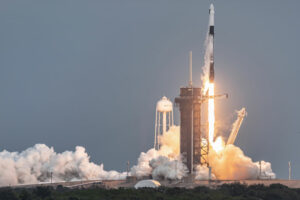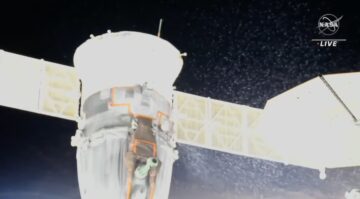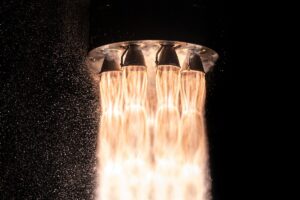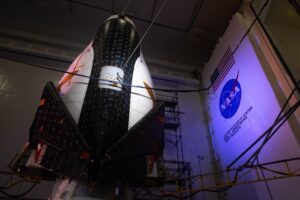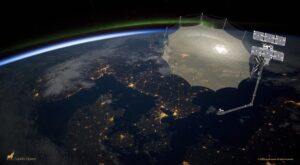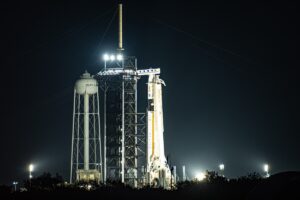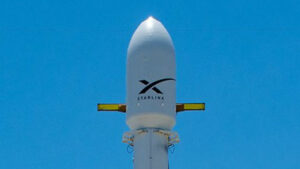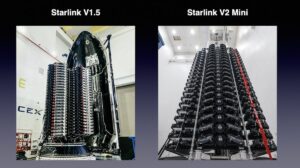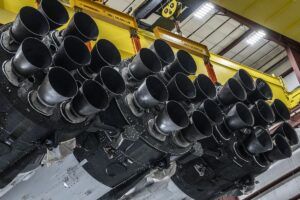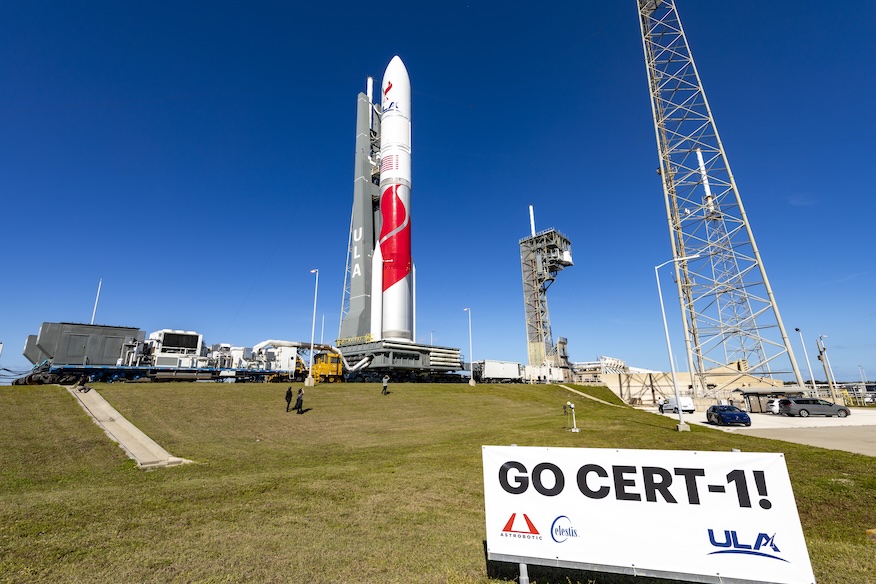
Nearly a decade of planning, designing, assembly and testing for United Launch Alliance (ULA) is about to culminate in the first launch of its Vulcan rocket. The maiden flight of the launch vehicle is set for Monday, Jan. 8, at 2:18 am EST (0718 UTC) from Space Launch Complex 41 at Cape Canaveral Space Force Station.
The fully assembled rocket emerged from the Vertical Integration Facility around 10:40 a.m. EST on Friday to travel the roughly 500-meter journey to the launch pad. After the 61.6-meter-tall (202 feet) rocket completed its trek, ULA teams spent the rest of the day performing leak checks on the umbilicals that will fuel the rocket and checking out the guidance and flight termination systems.
That’s how we roll. #ToryTimelapse #VulcanRocket pic.twitter.com/3bz9LgMZ0r
— Tory Bruno (@torybruno) January 5, 2024
Onboard, the primary payload, Astrobotic’s Peregrine lunar lander, is awaiting its ride to the Moon. It was hoisted atop the rocket inside the 15.5-meter-long (51 feet) payload fairing, manufactured by Beyond Gravity, on Dec. 20. Peregrine will be launched into a trans-lunar injection orbit to begin its journey to the Moon before the Centaur 5 upper stage continues on with Celestis Memorial Spaceflight’s “Enterprise Flight” to a heliocentric orbit around the Sun.
Mark Peller, ULA vice president of Vulcan Development, described the pending launch as a defining moment for many in the ULA company.
“It’s terribly exciting. It’s one of these once-in-your-career opportunities for most people and many people go through their whole career without ever getting this opportunity,” Peller said. “It’s been a lot of hard work, but it’s tremendously gratifying and it’s really helped us at ULA obviously develop our capabilities internally to bring new products to market.”
This version of the Vulcan rocket, a VC2S variant, is 61.6 meters (202 feet) tall and is initially powered by a combination of two Northrop Grumman GEM 63XL solid rocket boosters and two, methane/oxygen-fueled BE-4 engines from Blue Origin. The upper stage is powered by a pair of Aerojet Rockedyne-provided RL10C-1-1A engines that burn a combination of liquid oxygen and liquid hydrogen.
Starting in 2025, the Centaur 5 will use the upgraded RL10C-X engines that are currently being developed and tested by Aerojet Rocketdyne about 150 miles south of the Cape near West Palm Beach, Florida.
[embedded content]
The next few days will be a flurry of activity. On Sunday, the countdown to launch will start by powering on the Vulcan rocket at 3 p.m. EST (2000 UTC), 11 hours prior to liftoff. The launch complex will be cleared at L-6 hours (8 p.m. EST, 0100 UTC) and an hour later, they will start chilling the feed lines ahead of the start of tanking.
Vulcan is loaded with 454,000 kg (1 million lbs) of propellant, which is a combination of methane, liquid oxygen and liquid hydrogen. It weighs 663,367 kg (1,462,474 lbs.) once it’s fully fueled.
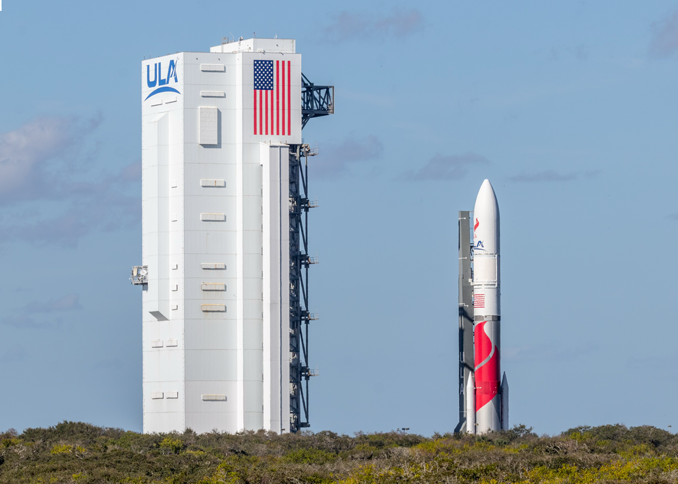
Gary Wentz, ULA vice president of Government and Commercial Programs, said tanking will be completed at L-2 hours (12:00 a.m. EST, 0500 UTC). During a media teleconference about the mission on Friday, Wentz was asked about a more detailed timeline, but declined to go into more specifics.
This will be the first time a major U.S. rocket has been introduced without the launch company providing a countdown timeline to the news media. ULA was also limiting news media access to countdown audio and video of the rocket to the final hour of the countdown after the propellant loading process will be complete.
“This is a flight test. This is our first test. The initial timeline that we have had some margin in it and over time, those timelines will change and I imagine more detail, as we go through the process, will come out,” Wentz said. “But right now, we’ll say there’s some margin built into the timelines and so, we’re going to work through that.”
Wentz noted that there is a planned 60-minute hold at T-7 minutes, during which the launch team will assess their technical readiness.
While the launch is currently planned for 2:18 a.m. EST (0718 UTC) on Jan. 8, there are multiple backup opportunities available to ULA:
- Jan. 8 – 2:18 a.m. EST / 0718 UTC (45 min. window)
- Jan. 9 – 12:15 a.m. EST / 0515 UTC (9 min. window)
- Jan. 10 – 12:12 a.m. EST / 0512 UTC (1 min. window)
- Jan. 11 – 12:14 a.m. EST / 0514 UTC (3 min. Window)
Wentz said the varying times are driven by a combination of “orbital mechanics and us being able to rendezvous for the lunar injection.”
“As we go through the flow, the number of back-to-back attempts will depend upon how far we go into the count, how much consumables/commodities we actually expend in the scrub process, assuming it’s a weather delay or something like that,” Wentz said.
He added that if none of those dates work out, the next launch opportunity opens on Jan. 23.
Ready for flight
ULA President and CEO Tory Bruno formally announced Vulcan to the world on April 13, 2015, about seven months after its announced partnership with Blue Origin to acquire BE-4 engines to power the booster stage of this new rocket. The pivot away from the Russian RD-180 engines used on the Atlas 5 rocket came after pressure from the U.S. Congress following Russia’s invasion of Crimea in 2014.
The rocket was planned to make its debut in 2019, but would go on to encounter years of delays in development as well as delays in the delivery of the BE-4 engines themselves. During a press briefing on Friday, Astrobotic CEO John Thornton said the legacy of ULA, which boasts a 100 percent mission success rate since its inception in 2006, was a big reason they chose Vulcan as their ride to space.
[embedded content]
“Vulcan has a new name, but it really is an upgraded Atlas 5, so that gives us great comfort in that as well,” Thornton said. “They’ve been a fantastic partner to us over the years in development of this capability in parallel with development of their rocket.”
Thornton added that because they are also operating on a constrained budget, they had to find creative ways to pay for their flight to the Moon. He said the risk of being on the debut flight of Vulcan helped a great deal with that.
“We chose United Launch Alliance’s first flight of Vulcan because we believe so much in the company and we’re very, very confident that this mission will be successful,” Thornton said. “And, of course, that came with some relief on the price and that makes this mission possible.”
Thornton didn’t go into detail on how much Astrobotic paid for the ULA flight, but NASA is paying Astrobotic $108 million to ferry its five payloads to the lunar surface as part of its Commercial Lunar Payload Services (CLPS) program. That was an increase from the original $79.5 million for 14 NASA payloads. The additional cost stemmed from supply chain impacts of COVID-19 and a shifting of the landing location in 2022, according to NASA’s Joel Kearns, and the offloaded payloads will fly on other CLPS missions.
Wentz added that Vulcan is predominantly legacy hardware with a series of upgrades or variants to them, which ULA believes helps instil further confidence.
“The only hardware that hasn’t flown prior to this flight is the BE-4 engine. All the other, or variants there to, have flown on either Atlas or Delta flights on missions for other customers,” Wentz said. “So, that gave us confidence to be able to offer this to support NASA and Astrobotic’s missions.”
Preparing for what comes next
This first launch for ULA’s Vulcan rocket is a crucial proving ground for the company as it looks towards the critically important missions that are part of the U.S. Space Force’s National Security Space Launch (NSSL) program. Vulcan needs to complete two certification flights before it can launch its first NSSL mission.
After the Peregrine flight checks the box for Cert-1, ULA aims to launch Sierra Space’s Dream Chaser spaceplane to the International Space Station on the Cert-2 mission. Peller said after Cert-1 launches, they set aside 60 days for a data review and to ensure they’re ready to move on.
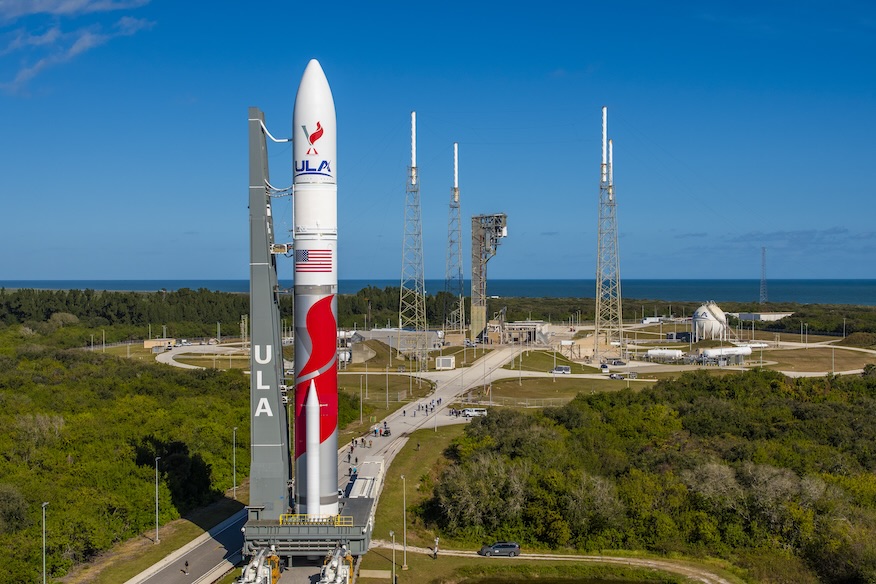
They hope to launch the Cert-2 mission around April, a month currently set to feature another ULA mission to the ISS: the launch of the Crew Flight Test mission for Boeing’s Starliner spacecraft. It’s unclear if both missions would launch within the same month.
Wentz said ULA has six Vulcan flights currently on the 2024 manifest with the four non-certification flights all poised to be NSSL missions. In addition to that, the company is also planning to fly nine Atlas 5 rockets and the final Delta 4 Heavy rocket.
“Next year, the rate increases to a total of on the order of 28 launches for the year,” Wentz said. “We’re also putting in place a secondary capability where we can do vertical integration of a second vehicle in parallel. And once that capability is brought on board, our flight rate will increase.”
- SEO Powered Content & PR Distribution. Get Amplified Today.
- PlatoData.Network Vertical Generative Ai. Empower Yourself. Access Here.
- PlatoAiStream. Web3 Intelligence. Knowledge Amplified. Access Here.
- PlatoESG. Carbon, CleanTech, Energy, Environment, Solar, Waste Management. Access Here.
- PlatoHealth. Biotech and Clinical Trials Intelligence. Access Here.
- Source: https://spaceflightnow.com/2024/01/06/ula-says-its-vulcan-rocket-is-finally-ready-to-fly/
- :has
- :is
- :where
- ][p
- 000
- 1
- 10
- 100
- 11
- 12
- 13
- 14
- 15%
- 150
- 20
- 2000
- 2006
- 2014
- 2015
- 2019
- 202
- 2022
- 2024
- 2025
- 220
- 23
- 28
- 360
- 40
- 41
- 51
- 60
- 678
- 8
- 9
- a
- Able
- About
- above
- access
- According
- acquire
- activity
- actually
- Adam
- added
- addition
- Additional
- After
- ahead
- aims
- All
- Alliance
- also
- am
- an
- and
- announced
- Another
- approaches
- April
- ARE
- around
- AS
- aside
- assembled
- Assembly
- assess
- At
- atlas
- Attempts
- audio
- available
- awaiting
- away
- Backup
- BE
- Beach
- because
- been
- before
- begin
- being
- believe
- believes
- Beyond
- Big
- Blue
- blue origin
- board
- boasts
- booster
- BOOSTERS
- both
- Box
- Briefing
- bring
- brought
- Bruno
- budget
- Building
- built
- burn
- but
- by
- came
- CAN
- capabilities
- capability
- cape
- Career
- carry
- ceo
- Certification
- chain
- change
- checking
- Checks
- chose
- combination
- come
- comes
- comfort
- commercial
- company
- complete
- Completed
- complex
- confidence
- confident
- Congress
- content
- continues
- Cost
- countdown
- course
- COVID-19
- Creative
- crew
- crucial
- Currently
- Customers
- data
- Dates
- day
- Days
- deal
- debut
- dec
- decade
- deep
- defining
- delay
- delays
- delivery
- Delta
- depend
- described
- designing
- detail
- detailed
- develop
- developed
- Development
- do
- dream
- driven
- during
- earth
- either
- embedded
- emerged
- encounter
- Engine
- Engines
- ensure
- EVER
- exciting
- explained
- Facility
- fantastic
- far
- Feature
- Feet
- few
- final
- Finally
- Find
- First
- first time
- five
- flight
- Flights
- florida
- flow
- flurry
- following
- For
- Force
- Formally
- four
- Friday
- from
- Fuel
- fueled
- fully
- further
- gave
- Gem
- getting
- gives
- Go
- going
- Government
- gravity
- great
- Ground
- guidance
- had
- Hard
- hard work
- Hardware
- Have
- he
- heavy
- helped
- helps
- High
- highly
- hold
- hope
- hour
- HOURS
- How
- http
- HTTPS
- hydrogen
- i
- if
- image
- imagine
- Impacts
- important
- in
- inception
- Increase
- Increases
- initial
- initially
- Initiative
- inside
- integration
- internally
- International
- international space station
- into
- introduced
- invasion
- ISS
- IT
- ITS
- Jan
- joel
- John
- journey
- jpg
- landing
- later
- launch
- launched
- launches
- leak
- Legacy
- like
- lines
- Liquid
- loading
- location
- LOOKS
- Lot
- Lunar
- lunar lander
- major
- make
- MAKES
- manufactured
- many
- many people
- Margin
- Market
- max-width
- mechanics
- Media
- Memorial
- methane
- million
- min
- minutes
- Mission
- missions
- moment
- Monday
- Month
- months
- Moon
- more
- most
- move
- much
- multiple
- name
- Nasa
- National
- national security
- Near
- needs
- New
- new products
- news
- news media
- next
- nine
- None
- noted
- now
- number
- of
- offer
- on
- once
- ONE
- only
- opens
- operating
- opportunities
- Opportunity
- or
- Orbit
- order
- Origin
- original
- Other
- our
- out
- over
- Oxygen
- pad
- paid
- pair
- palm
- Parallel
- part
- partner
- Partnership
- Pay
- paying
- pending
- People
- percent
- performing
- photo
- Pivot
- Place
- planned
- planning
- plato
- Plato Data Intelligence
- PlatoData
- poised
- possible
- power
- powered
- Powering
- predominantly
- preparation
- president
- press
- pressure
- price
- primary
- Prior
- process
- Products
- Program
- Programs
- providing
- proving
- Putting
- Rate
- Readiness
- ready
- really
- reason
- relief
- REST
- review
- Ride
- right
- Risk
- rocket
- Roll
- rolls
- roughly
- russian
- s
- Said
- same
- say
- says
- Second
- secondary
- security
- Series
- Services
- set
- seven
- SHIFTING
- since
- SIX
- So
- solid
- some
- something
- South
- Space
- Space Force
- space station
- spacecraft
- spaceflight
- specifics
- spent
- Stage
- start
- station
- stemmed
- success
- successful
- Sun
- sunday
- supply
- supply chain
- support
- Surface
- Systems
- team
- teams
- Technical
- test
- tested
- Testing
- than
- that
- The
- the world
- their
- Them
- themselves
- There.
- These
- they
- this
- those
- Through
- time
- timeline
- timelines
- times
- to
- Total
- towards
- transported
- travel
- tremendously
- true
- two
- u.s.
- u.s. congress
- unclear
- United
- upgraded
- upgrades
- upon
- us
- use
- used
- UTC
- Variant
- varying
- vehicle
- version
- vertical
- very
- vice
- Vice President
- Video
- vulcan
- was
- ways
- we
- Weather
- weighs
- WELL
- West
- What
- which
- whole
- will
- window
- with
- within
- without
- Work
- work out
- world
- would
- year
- years
- youtube
- zephyrnet

